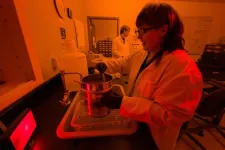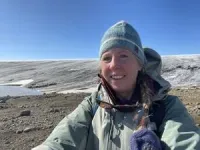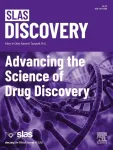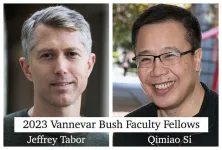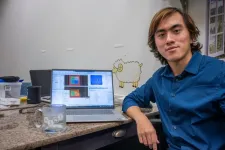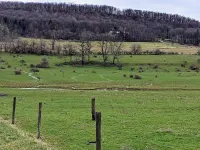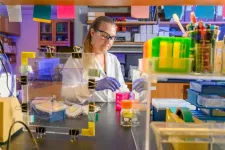(Press-News.org) LOGAN, UTAH, USA -- New analysis of samples collected from underneath Greenland’s ice sheet reveal the Arctic island was much greener as recently as 416,000 years ago. The findings overturn previous views that Greenland’s continental glacier, which covers about 80 percent of the 836,3000-square-mile land mass, has persisted for the last two and a half million years.
“We’re discovering the ice sheet is much more sensitive to climate change than we previously thought,” says Utah State University geoscientist Tammy Rittenour. “This is a foreboding wake-up call.”
Rittenour, with colleagues from the University of Vermont and fourteen other institutions, reports findings in the July 20, 2023, issue of the journal Science. Their research is supported by the National Science Foundation.
A greener Greenland means the island’s formidable-appearing ice sheet – nearly two miles thick in places – is not as stable as it appears.
“We had always assumed the ice sheet has remained about the same for nearly 2.5 million years,” says Rittenour, professor in USU’s Department of Geosciences. “But our investigation indicates it melted enough to allow the growth of moss, shrubs and buzzing insects during an interglacial period called Marine Isotope Stage 11, between 424,000 to 374,000 years ago.”
The melting caused at least five feet of sea-level rise around the globe, she says. “Some of our model scenarios suggest sea levels up to 20 feet higher than today.”
“It was an unusually long period of warming with moderately elevated levels of carbon dioxide – CO2 – in the atmosphere,” Rittenour says. “What’s alarming about this finding is today’s CO2 levels are 1.5 times higher.”
Even if humans abruptly stopped activities that contribute to greenhouse gas emissions, she says, “we’d still have inflated CO2 levels for hundreds, maybe even thousands, of years to come.”
That’s an uneasy realization, she says, with current rates at which Greenland’s ice sheet is thawing.
“And that’s not taking Antarctica and other glacial areas into consideration,” Rittenour says. “The deglaciation has implications for the entire globe and is especially sobering for our coastal mega-cities, where so much of the world’s population resides.”
The team’s analysis is a continuation of research started several years ago, when the scientists happened upon samples collected from an extraordinary, Cold War-era military project.
“In 1960, the U.S. Army launched a top-secret effort called Project Iceworm in northwestern Greenland to build a network of mobile nuclear launch sites under the ice sheet,” Rittenour says. “As part of that project, they also invited scientists and engineers to conduct experiments in a highly publicized ‘cover’ project, known as Camp Century, to study the feasibility of working and carrying out military missions under ice and in extreme-cold conditions.”
Hampered by brutal blizzards and unstable ice conditions, Project Iceworm’s cavernous underground bunker and tunnels were abandoned in 1966. But sediment samples collected at the bottom of a more than 4,000-foot-long ice core extracted from the site have yielded the surprising information about Greenland’s not-so-distant geologic past.
The frozen soil samples from the base of the Camp Century ice core were forgotten in a freezer for decades, until recently re-discovered.
“We have very few samples from below the Greenland ice sheet, because most drilling missions stop when they reach the base of the ice,” Rittenour says. “These re-discovered Camp Century sediments represent a unique, unspoiled time capsule of past conditions.”
While the frozen soil sat in a freezer for more than 60 years, science technology advanced. Rittenour, who is director of the USU Luminescence Laboratory, was invited to help date the sediment.
“Because the samples remained frozen and largely untouched, I was able to use luminescence dating to determine the last time they were exposed to sunlight,” she says. “If researchers had examined the sediments in the past, we couldn’t have run any of the analyses we did for this paper.”
Rittenour says today’s investigative technologies enable researchers to distill a good record of what’s happened in Greenland and other parts of the world.
“These once lost, Cold War relics from a top-secret nuclear military base carved within the ice are continuing to tell their secrets, and forewarn us of the sensitivity of Earth’s climate,” she says. “If we can lose the far northwest portion of the Greenland ice sheet under natural conditions, then we’re treading dangerous waters given current elevated greenhouse gas conditions.”
###
END
Greenland has greener history than previously thought, says USU Geoscientist
Tammy Rittenour and colleagues report much of the Artic island's ice melted as recently as 416,000 years ago, which has implications for sea-level rise
2023-07-20
ELSE PRESS RELEASES FROM THIS DATE:
New advancements in assay development research
2023-07-20
Oak Brook, IL – The July 2023 issue of SLAS Discovery, the open access journal focused on research progressing drug discovery, is now available. Volume 28, Issue 5, contains one short communication and four full-length articles covering assay quality metrics, fluorescence resonance energy transfer (FRET) and small molecule glycomimetics and other high-throughput screening-related research.
Full-length articles
Mathematical relationships between control group variability and assay quality metrics
Authored by early ...
The present and future of computing get a boost from new research
2023-07-20
The world's computing needs have grown exponentially in recent years due to an explosion of technology. To meet the needs for the next technological leap, the scientific community is working to improve current processing capabilities and simultaneously develop entirely new computing methods.
Two new papers from the research group of Jean Anne Incorvia, a professor in the Cockrell School of Engineering’s Chandra Family of Electrical and Computer Engineering, aim to contribute to both of these scientific needs. Together, they offer improvements ...
The largest study of its kind shows a need for improvement in esophageal cancer screenings
2023-07-20
A new study published in Gastroenterology aims to improve the effectiveness of screening and surveillance practices for early cancer detection in Barrett’s esophagus (BE).
BE is the only identifiable precursor lesion for esophageal adenocarcinoma (EAC), a lethal cancer with increased incidence and mortality rates over the last several decades.
The research, led by faculty at the University of Colorado (CU) Cancer Center, analyzed a large international database of over 20,000 newly diagnosed BE patients in Nordic countries to provide a more accurate look at how many patients have normal ...
Damon Runyon Cancer Research Foundation awards $3.6 million to top clinical investigators
2023-07-20
The Damon Runyon Cancer Research Foundation has named six new Damon Runyon Clinical Investigators. The recipients of this prestigious award are outstanding, early-career physician-scientists conducting patient-oriented cancer research at major research centers under the mentorship of the nation's leading scientists and clinicians.
The Clinical Investigator Award program was designed to increase the number of physicians capable of moving seamlessly between the laboratory and the patient’s ...
Rice researchers earn prestigious Defense Department grants
2023-07-20
HOUSTON – (July 20, 2023) – Rice University professors Qimiao Si and Jeffrey Tabor, are recipients of prestigious Vannevar Bush Faculty Fellowships from the United States Department of Defense.
Si, a theoretical quantum physicist, and Tabor, a bioengineer and synthetic biologist, are among 10 members of the 2023 class of Bush fellows named by the department’s Basic Research Office.
The highly competitive, five-year fellowships are among the federal government’s most prestigious individual research honors. Bush fellowships are awarded annually and include $3 million to pursue ...
Discovery may lead to terahertz technology for quantum sensing
2023-07-20
HOUSTON – (July 20, 2023) – Visible light is a mere fraction of the electromagnetic spectrum, and the manipulation of light waves at frequencies beyond human vision has enabled such technologies as cell phones and CT scans.
Rice University researchers have a plan for leveraging a previously unused portion of the spectrum.
“There is a notable gap in mid- and far-infrared light, roughly the frequencies of 5-15 terahertz and wavelengths ranging from 20-60 micrometers, for which ...
USDA grant funds study of effectiveness of vegetation to curb water pollution
2023-07-20
UNIVERSITY PARK, Pa. — At a time when Pennsylvania is actively working to achieve water-quality improvements to meet the state’s obligations for cleaning up the Chesapeake Bay, a multidisciplinary Penn State research team is studying whether agricultural pollution-prevention devices called riparian buffers are working properly.
Riparian buffers — areas adjacent to streams or wetlands that contain a combination of trees, shrubs and grasses — are managed differently from the surrounding landscape to provide conservation benefits. In agricultural areas, buffers intercept sediment, nutrients, pesticides and chemicals ...
Researchers reveal why obesity makes ovarian cancer more deadly
2023-07-20
Most women with ovarian cancer are diagnosed with the most advanced form of the disease. Less than a third of those diagnosed with the disease survive five years later. As the third most common type of gynecological cancer, it led to more than 200,000 reported deaths globally in 2020 alone, according to a recent study.
In a study published this month in the Journal of Experimental & Clinical Cancer Research, University of Notre Dame researchers in collaboration with NeoGenomics Laboratories ...
Frontiers adopts CRediT to enhance clarity in research authorship
2023-07-20
Frontiers journals have adopted the Contributor Roles Taxonomy (CRediT) to improve the way authors' contributions to research are communicated and acknowledged. The new system replaces the conventional free-text authorship descriptions with a standardized and transparent system that ensures consistency and accuracy in recognizing individual contributions.
CRediT categorizes individual author contributions into well-defined roles and provides a clear, concise framework to describe the diverse contributions made by researchers ...
New findings show private equity investments in healthcare may not lower costs or improve quality of care
2023-07-20
A research team supervised by a health policy researcher at the University of Chicago has found that increasingly common private equity investments in healthcare are generally associated with higher costs to patients and payers. That’s according to a new study published July 19 in The BMJ. The study is thought to be the first systematic review of global private equity ownership trends in medical settings.
“Over the last few decades, private equity activity in healthcare has exploded, with financial institutions buying up hospitals, nursing homes and fertility ...
LAST 30 PRESS RELEASES:
First Editorial of 2026: Resisting AI slop
Joint ground- and space-based observations reveal Saturn-mass rogue planet
Inheritable genetic variant offers protection against blood cancer risk and progression
Pigs settled Pacific islands alongside early human voyagers
A Coral reef’s daily pulse reshapes microbes in surrounding waters
EAST Tokamak experiments exceed plasma density limit, offering new approach to fusion ignition
Groundbreaking discovery reveals Africa’s oldest cremation pyre and complex ritual practices
First breathing ‘lung-on-chip’ developed using genetically identical cells
How people moved pigs across the Pacific
Interaction of climate change and human activity and its impact on plant diversity in Qinghai-Tibet plateau
From addressing uncertainty to national strategy: an interpretation of Professor Lim Siong Guan’s views
Clinical trials on AI language model use in digestive healthcare
Scientists improve robotic visual–inertial trajectory localization accuracy using cross-modal interaction and selection techniques
Correlation between cancer cachexia and immune-related adverse events in HCC
Human adipose tissue: a new source for functional organoids
Metro lines double as freight highways during off-peak hours, Beijing study shows
Biomedical functions and applications of nanomaterials in tumor diagnosis and treatment: perspectives from ophthalmic oncology
3D imaging unveils how passivation improves perovskite solar cell performance
Enriching framework Al sites in 8-membered rings of Cu-SSZ-39 zeolite to enhance low-temperature ammonia selective catalytic reduction performance
AI-powered RNA drug development: a new frontier in therapeutics
Decoupling the HOR enhancement on PtRu: Dynamically matching interfacial water to reaction coordinates
Sulfur isn’t poisonous when it synergistically acts with phosphine in olefins hydroformylation
URI researchers uncover molecular mechanisms behind speciation in corals
Chitin based carbon aerogel offers a cleaner way to store thermal energy
Tracing hidden sources of nitrate pollution in rapidly changing rural urban landscapes
Viruses on plastic pollution may quietly accelerate the spread of antibiotic resistance
Three UH Rainbow Babies & Children’s faculty elected to prestigious American Pediatric Society
Tunnel resilience models unveiled to aid post-earthquake recovery
Satellite communication systems: the future of 5G/6G connectivity
Space computing power networks: a new frontier for satellite technologies
[Press-News.org] Greenland has greener history than previously thought, says USU GeoscientistTammy Rittenour and colleagues report much of the Artic island's ice melted as recently as 416,000 years ago, which has implications for sea-level rise
